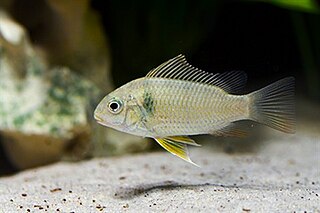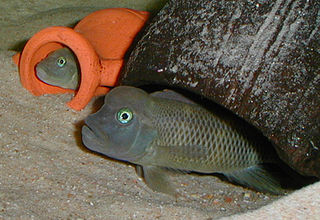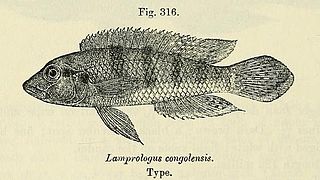
The Congo River, formerly also known as the Zaire River, is the second-longest river in Africa, shorter only than the Nile, as well as the third-largest river in the world by discharge volume, following the Amazon and Ganges rivers. It is the world's deepest recorded river, with measured depths of around 220 m (720 ft). The Congo–Lualaba–Luvua–Luapula–Chambeshi River system has an overall length of 4,700 km (2,900 mi), which makes it the world's ninth-longest river. The Chambeshi is a tributary of the Lualaba River, and Lualaba is the name of the Congo River upstream of Boyoma Falls, extending for 1,800 km (1,100 mi).

Lake Mai-Ndombe is a large freshwater lake in Mai-Ndombe province in western Democratic Republic of the Congo. The lake is within the Tumba-Ngiri-Maindombe area, the largest Wetland of International Importance recognized by the Ramsar Convention in the world.

Crenicichla is a genus of cichlids native to South America commonly known as the pike cichlids. They are found in most tropical and subtropical freshwater habitats between the Andes and the Atlantic.

Nanochromis is a genus of small cichlids endemic to the Congo River Basin in Central Africa.

Tilapia is a genus of cichlid fishes endemic to freshwater habitats in Southern Africa. In the past this was a very large genus including all species with the common name tilapia, but today the vast majority are placed in other genera.

Teleocichla is a genus of fish in the family Cichlidae found in the Tapajós, Xingu, Tocantins and Jari River basins, which are part of the Amazon River Basin in Brazil. All species are rheophilic, and highly elongated in shape. They generally are smaller than 9 cm (3.5 in) in length, making them some of the smallest cichlids of the Americas. Only T. preta can grow larger, reaching about 12 cm (4.7 in). Since restricted to areas with fast currents, they are particularly vulnerable to the building of dams, and the Belo Monte Dam may cause the extinction of T. centisquama. Other species recognized as threatened by Brazil's Ministry of the Environment are T. cinderella, T. prionogenys and T. wajapi.

Etia nguti is a species of cichlid fish endemic to Cameroon in Central Africa where it is only known from the Nguti River, a tributary of the Cross-Manyu River. This species can reach up to 13.3 centimetres (5.2 in) in standard length. It is the only member of its genus and tribe.
Mastacembelus is a genus of many species of spiny eel fish from the family Mastacembelidae. They are native to Africa and Asia. Most are found in rivers and associated systems, but there are also species in other freshwater habitats and a particularly rich radiation is found in the Lake Tanganyika basin with 15 species. A few species can even occur in brackish water.

Heterochromis is a genus of cichlid fish in the order Perciformes. It is the only genus of the subfamily Heterochromidinae, and contains a single species, Heterochromis multidens, which is endemic to the Congo River Basin in Central Africa. The relationships of Heterochromis to other cichlids have long been controversial, with several morphological features suggesting that it is more closely related to American cichlids than to other African species. Molecular studies have given contradictory results. The most comprehensive analysis done to date found more support for relationship to African cichlids, but could not conclusively reject a relationship to the American clade.

Orthochromis is a genus of relatively small haplochromine cichlids native to rivers and lakes in Eastern and Middle Africa. Most of its species are rheophilic.

The Pseudocrenilabrinae are a subfamily in the cichlid family of fishes to which, according to a study from 2004, includes all the Middle Eastern and African cichlids with the exception of the unusual Heterochromis multidens and the Malagasy species. This subfamily includes more than 1,100 species. Previous authors recognized additional African subfamilies, e.g. the Tilapiinae of Hoedeman (1947), Tylochrominae of Poll (1986), or Boulengerochrominae of Tawil (2001).

Chromidotilapiini is a tribe of small cichlids from tropical West and Middle Africa. There are thirteen genera and over fifty described species in this tribe.

The lionhead cichlid, also known as African blockhead, buffalohead, humphead cichlid, lionhead or lumphead is a species of rheophilic cichlid native to Pool Malebo and the Congo River. It uses caves for spawning. This species can reach a length of 10 centimetres (3.9 in) TL. This species can also be found in the aquarium trade.

Tilapia busumana is a species of cichlid native to Lake Bosumtwi, the Bia River Basin, the Pra River Basin and the Tano River Basin in Ghana and Côte d'Ivoire. This species can reach a length of 18 centimetres (7.1 in) SL. It can also be found in the aquarium trade. In 2013, research published by Dunz & Schliewen indicated that this species does not belong in the genus Tilapia, but is rather closer to "Steatocranus" irvinei and Gobiocichla. It is currently retained in Tilapia pending further research.

The Yellala Falls are a series of waterfalls and rapids on the Congo River just upstream from Matadi in the Democratic Republic of the Congo. The falls are the lowest of a long series of rapids that render the river unnavigable, forcing colonial explorers to travel by foot as far as the Stanley Pool 350 kilometres (220 mi) upstream. The Congo is the second largest river in the world by volume of water discharged, and the deepest in the world. The section of river that ends with the Yellala falls has over 300 species of fish, many found nowhere else.
Hylopanchax is a genus of poeciliids native to the Congo River Basin and Ivindo River in Middle Africa.

Cichlidogyrus is a genus of monopisthocotylean monogeneans in the family Ancyrocephalidae. The type-species of the genus is Cichlidogyrus arthracanthusPaperna, 1960, by original designation. All the species of the genus are parasites on the gills of fish, namely African Cichlidae, Nandidae and Cyprinodontidae.

Lamprologus congoensis, the Congo lionhead cichlid is a species of riverine cichlid which is widespread in the Congo River, it is the type species of the genus Lamprologus.

Cichlidogyrus kmentovae is a species of monopisthocotylean monogenean in the family Ancyrocephalidae. It is a parasite of the gills of the fish Hemichromis stellifer of the lower Basin of River Congo.

Steatocranus bleheri is species of fish in the cichlid family. It is endemic to the Kafubu River system, which is part of the Luapula drainage in the upper Congo River basin, in the Democratic Republic of the Congo.




















